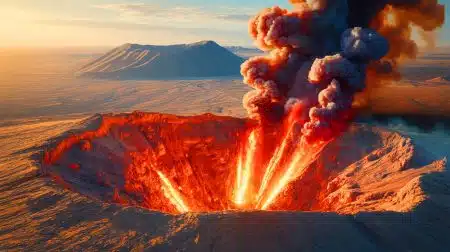| IN A NUTSHELL |
|
In 2014, a colossal subglacial flood erupted from beneath the Greenland Ice Sheet, sending shockwaves through the scientific community. The recent findings from this extraordinary event have challenged traditional understandings of ice sheet dynamics. Researchers have uncovered the mechanisms that drove this massive subglacial lake to burst upwards with explosive force, fracturing the surface ice and reshaping the landscape. This revelation has significant implications for our understanding of ice sheet stability and climate change. As we delve into the details of this event, the broader significance for global sea-level rise and climate models becomes clear.
The Unseen Power of Subglacial Water
In a remote part of northern Greenland, a hidden subglacial lake unleashed approximately 90 million cubic meters of water over a span of ten days. This volume is equivalent to the peak flow of Niagara Falls over nine hours. The water tore through the ice, forming an 85-meter-deep crater across a two-square-kilometer area. This stands as one of the largest subglacial floods recorded in Greenland.
The aftermath revealed a dramatically altered landscape. Over 385,000 square meters, an area the size of 54 football fields, was marred with deep crevasses and towering ice blocks reaching heights of 25 meters. Surrounding this chaotic zone was an additional six square kilometers of scoured terrain, nearly twice the size of Central Park in New York.
Researchers were stunned by the power and scope of the flood. Dr. Jade Bowling, the study’s lead author, noted their initial disbelief. “When we first saw this, we thought there must be a problem with the data,” she explained. But as evidence mounted, it became undeniable that they were witnessing the remnants of a massive flood forcing its way through the ice.
Challenging Existing Models
The event has upended conventional models of Greenland’s ice sheet behavior. Traditionally, models assumed that meltwater travels downward through the ice, eventually reaching the ocean. This study, however, demonstrates that under extreme pressure, subglacial water can defy expectations by moving upward, fracturing the ice from below.
These observations suggest that existing models may underestimate the vulnerability of the ice sheet. The flood occurred in an area where the ice bed was thought to be frozen solid, leading researchers to propose a new mechanism. Extreme water pressure may have caused fracturing at the ice base, allowing water to erupt through the ice to the surface.
Dr. Amber Leeson, a co-author of the study, emphasized the implications. “This flood shows us that the ice sheet can respond in ways we didn’t expect,” she said. This unexpected behavior is a wake-up call to explore processes that remain poorly understood.
Importance of Long-term Observations
The role of satellite data in detecting such hidden events has proven invaluable. Professor Mal McMillan, co-director of the UK Centre for Polar Observation and Modelling, highlighted the importance of these observations. “This kind of event would have gone unnoticed without long-term satellite data,” he stated. This underscores the critical role of continuous monitoring in tracking climate change in real time.
Most ice sheet models have previously overlooked the potential for upward-directed floods like this one, focusing instead on lateral or downward meltwater movement. This oversight could impact projections of ice sheet stability in a warming climate, where surface melting is expected to intensify and spread.
To address these challenges, scientists stress the need for models that reflect the full complexity of subglacial hydrology. Continued monitoring from missions like ESA’s CryoSat and NASA’s ICESat-2 will be vital for detecting hidden lakes and understanding their behavior.
Global Implications and Future Research
The Greenland Ice Sheet contains enough ice to raise global sea levels by over 23 feet. Understanding how subglacial water moves and disrupts the ice is crucial for predicting future behavior. The findings from this study have broad implications for global sea-level rise and climate projections.
The research was a collaborative effort involving over a dozen institutions worldwide, including Lancaster University, Northumbria University, and the Geological Survey of Denmark and Greenland. Published in Nature Geoscience, it represents a significant advancement in our understanding of ice sheet dynamics.
As climate change continues to accelerate, the frequency of such extreme water surges may increase. This underscores the urgency for models to evolve and capture the complexity of these processes. The international scientific community must continue to investigate these hidden forces to refine predictions and inform policy decisions.
As we grapple with the realities of a changing climate, the question remains: how will this newfound understanding of subglacial dynamics shape our approach to mitigating the impacts of global warming on ice sheets and sea-level rise?
Did you like it? 4.3/5 (22)






Wow, this is terrifying! 🌍 What can we do to prevent more of these floods?
How did no one notice this massive flood until now? 😲
Is this a sign we should be investing more in climate research? 🔬
I’m skeptical. It seems like every year there’s a new “climate crisis” article.
Thanks for the detailed explanation. This really puts things into perspective!
Does this mean coastal cities are in even more danger now?
Another reason to be worried about climate change… great. 😒
So the ice can just explode now? What’s next, flying polar bears? 😂
Why wasn’t this on the news earlier? Seems like a big deal.